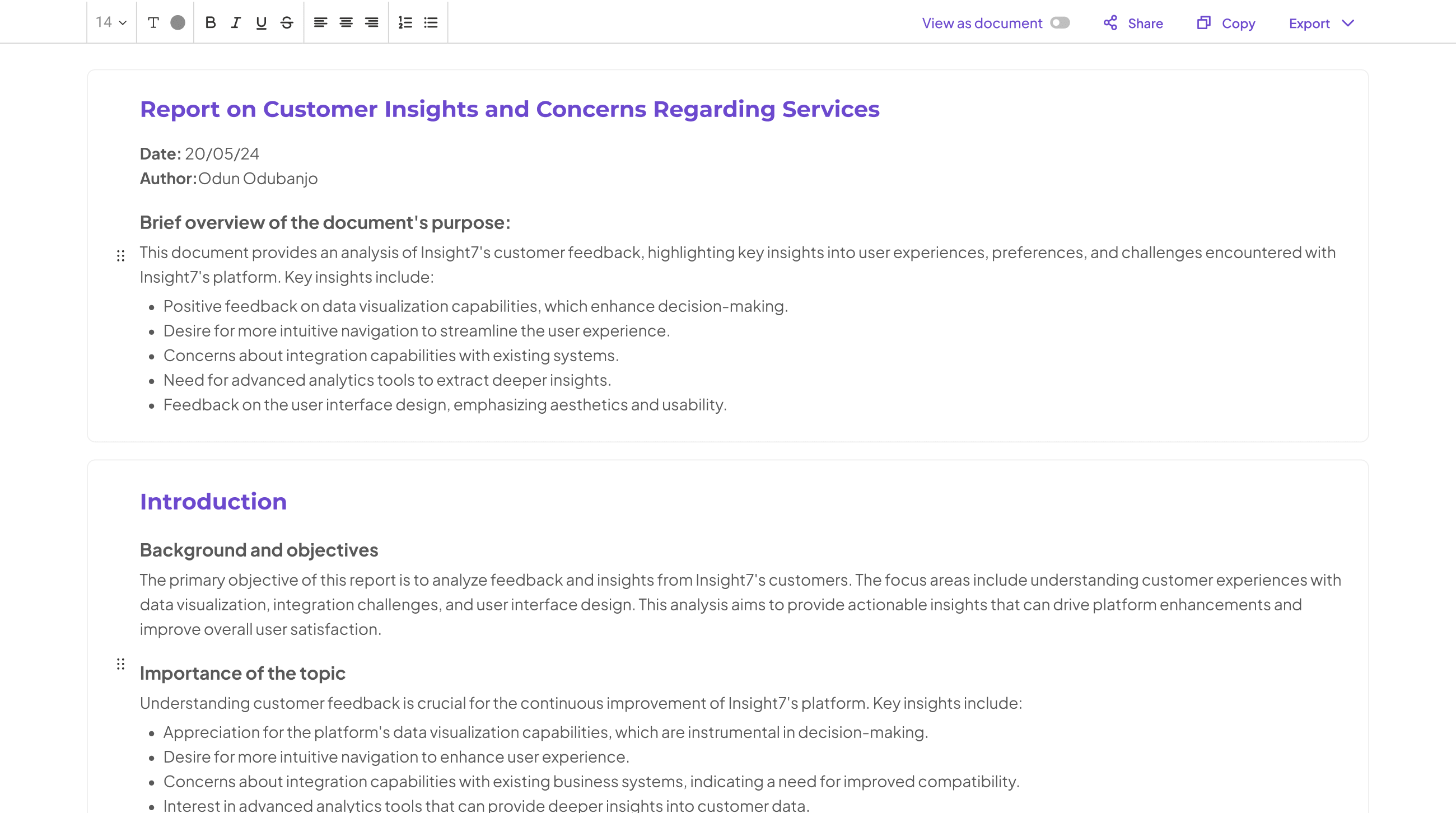How to generate reports from prospect calls
-
Hello Insight
- 10 min read
Prospect Call Reporting is a vital process that transforms raw call data into actionable insights. Imagine a sales team struggling to understand customer needs from scattered conversations. By employing structured reporting, they can pinpoint pain points and enhance strategies to meet client demands effectively.
Understanding how to generate reports from prospect calls allows businesses to visualize critical trends and patterns. This ensures that each interaction is meaningful and contributes directly to decision-making. By analyzing the right data, teams can create comprehensive, effective reports that drive performance and foster continuous improvement.
Transcribe & extract insights from interviews. At Scale.

Understanding the Basics of Prospect Call Reporting
Prospect Call Reporting is an essential practice that helps organizations evaluate their outreach efforts effectively. Understanding the basics of this reporting can significantly enhance your team's sales performance. It involves systematically collecting and analyzing data from prospect calls to identify trends, successes, and areas that require improvement.
The first step in Prospect Call Reporting is to ensure that accurate data is collected from each call. This includes noting critical metrics such as call duration, the purpose of the call, and customer responses. Following this, it’s important to analyze the details gathered from these calls to generate comprehensive reports. These reports should highlight key performance indicators, allowing businesses to track progress and identify best practices for future outreach. By mastering these basics, teams can refine their strategies, improve training programs, and ultimately achieve better sales outcomes.
Importance of Accurate Data Collection
Accurate data collection is vital for generating meaningful prospect call reports. When sales teams engage with potential customers, the details gathered can ultimately shape marketing strategies and decision-making processes. Each conversation provides insights into customer needs, preferences, and potential issues. Therefore, capturing accurate information allows organizations to make informed adjustments and stay competitive in the market.
Moreover, effective data collection promotes better analysis and reporting. By ensuring that all relevant details are recorded correctly, teams can identify patterns and trends that emerge from saved calls. This information can be leveraged to create tailored reports, facilitating actionable insights for ongoing training and development. In prospect call reporting, the quality of decisions hinges on the quality of data collected, demonstrating the significant role accuracy plays in the overall effectiveness of the sales process.
Analyzing Call Details for Comprehensive Reports
Analyzing call details is essential for producing comprehensive reports that are informed by data-driven insights. By examining recorded prospect calls, teams can identify key trends, strengths, and areas needing improvement. This process goes beyond mere keyword tracking; it evaluates conversation quality against established benchmarks, ensuring that team members meet compliance and performance standards.
To facilitate thorough analysis, consider these key areas: establishing clear objectives for what to learn from each call, gathering relevant data from all conversations, and utilizing advanced reporting tools that can provide actionable insights. By focusing on these aspects, teams can enhance training and coaching initiatives, leading to improved performance outcomes. Continuous assessment of call metrics not only helps in compliance auditing but also fosters a culture of continuous improvement throughout the organization.
Generate Detailed Reports from Your Qualitative Data in Minutes.
Steps to Generate Effective Prospect Call Reports
To generate effective prospect call reports, begin by clearly defining your objectives and metrics. Understanding what information is vital is essential for a meaningful analysis. This step ensures that you capture data relevant to your goals, whether those are improving customer engagement or evaluating product knowledge during calls.
Next, gather and organize the call data systematically. Create a structured format that allows easy access to details such as call transcripts, evaluations, and any feedback. This organization will facilitate analysis and help in deriving actionable insights. Utilize software tools that support this process, ensuring you can automate data gathering and enhance reporting accuracy. Selecting the right tools, like HubSpot CRM or Insight7, can streamline your workflow, making it easier to generate comprehensive reports that drive better decision-making and enhance overall prospect call effectiveness.
Step 1: Setting Objectives and Metrics
Setting clear objectives and metrics is essential for effective Prospect Call Reporting. Start by defining what you aim to achieve through your calls. Are you looking to understand customer pain points, gauge interest in your product, or gain insights into market trends? Identifying these goals will guide your reporting process and allow you to funnel your efforts toward specific outcomes.
Next, establish metrics that align with your objectives. Quantitative metrics, such as the number of successful leads generated, can provide measurable insight. Additionally, qualitative insights, such as customer feedback and engagement levels, can highlight areas for improvement. Tracking these metrics over time will not only help you quantify the effectiveness of your calls but also foster ongoing enhancements in your approach. Remember, a well-defined objective and robust metrics are crucial for generating meaningful reports from prospect calls.
Step 2: Gathering and Organizing Call Data
Gathering and organizing call data is a crucial step in effective prospect call reporting. Begin by systematically collecting data from all relevant calls. This includes noting key information such as the caller’s details, the purpose of the call, and the main points of discussion. Cataloging each call in a structured manner allows for easier analysis later on, enabling you to identify patterns and insights that drive decision-making.
Next, prioritize consistency in how you organize this data. Whether using spreadsheets or specialized software, ensure each entry follows a uniform format. This helps streamline the reporting process and ensures that details are easily accessible. Consider categorizing calls by type or outcome to enhance efficiency. By carefully gathering and organizing call data, you set the foundation for effective reporting, allowing you to pinpoint trends and optimize your prospect engagement strategies.
Step 3: Leveraging Tools for Enhanced Reporting
To streamline your prospect call reporting process, it’s crucial to utilize the right tools effectively. Implementing software solutions can significantly enhance how data from your calls are recorded, analyzed, and reported. By using a system tailored to your specific metrics, you can automate report generation, ensuring timely delivery without manual effort. Customizable dashboards will allow your team to visualize trends over time, making insights easily accessible.
When selecting reporting tools, consider those that integrate smoothly with your existing systems. The ideal tool will offer capabilities to aggregate data, generate monthly reports, and allow for real-time adjustments based on user feedback. For instance, systems like HubSpot CRM or Salesforce not only track calls but also provide tools for evaluating their impact. Ultimately, these technologies help ensure that your prospect call reporting is both efficient and informative, which aligns with your strategic goals.
Recommended Tools for Prospect Call Reporting
Effective prospect call reporting relies significantly on the right tools that can simplify data collection and analysis. To facilitate this process, consider several tools that can automate transcription, organize insights, and generate comprehensive reports. These platforms streamline the workflow, making it accessible for anyone within a business to extract valuable information without extensive training.
Some recommended tools include Insight7, which provides a robust framework for managing call data and analyzing customer feedback. HubSpot CRM and Salesforce offer integrated solutions for tracking interactions, while RingCentral enhances communication capabilities. Pipedrive and Zoho CRM also enable easy organization of call insights and metrics. Utilizing these tools not only aids in identifying pain points and opportunities but also empowers teams to create actionable reports, ultimately leading to informed decision-making and improved customer relationships.
- Insight7
Generating insightful reports from prospect calls is vital for understanding customer needs and enhancing sales strategies. Insight7 emphasizes the importance of accurately capturing and interpreting data from these interactions. When preparing to report on prospect calls, ensure that you set clear objectives. This allows you to align your data collection with specific business goals, making the reporting process more effective.
Next, gather and organize data meticulously. Each call can yield valuable insights, so take time to document key points, customer responses, and any follow-up questions. Using advanced tools can significantly improve the efficiency of your reporting process. Consider options like those mentioned earlier, which help streamline data analysis and report generation. This organized approach will not only facilitate better decision-making but also foster collaboration among teams, ultimately driving business growth through well-informed strategies.
- HubSpot CRM
HubSpot CRM is a powerful tool for managing and analyzing prospect call reporting. It allows organizations to seamlessly capture and store all pertinent information from sales calls. This functionality transforms raw call data into actionable insights that can significantly enhance marketing and sales strategies.
By integrating features like automated call transcription and data analysis, HubSpot CRM streamlines the process of generating detailed reports. This ensures teams can quickly assess the effectiveness of their prospect engagement tactics. Users can categorize calls based on various attributes, such as success rates and customer feedback. Furthermore, the platform enables real-time querying of data, allowing teams to identify patterns and topics of concern among prospects. Making the most of HubSpot CRM ultimately pivots teams from conventional sales approaches to more consultative, relationship-driven engagements, which are vital in today’s competitive landscape.
- Salesforce
Salesforce serves as a pivotal tool for prospect call reporting, enabling businesses to efficiently track and analyze call interactions. By utilizing Salesforce, companies can seamlessly gather data from calls and transform it into actionable insights. This powerful platform allows users to categorize calls, identify key keywords, and assess overall performance, which is essential for compliance and improvement.
To generate effective reports from prospect calls, you can follow several key steps. First, ensure that your Salesforce account is set up to capture important call data. This includes not just the call recording but also relevant metadata like call duration and participant information. Second, take advantage of Salesforce's reporting features, which allow you to filter and sort data based on specific metrics. Lastly, regularly review and adjust your reporting criteria to align with evolving compliance needs and organizational objectives. By doing so, you solidify your prospect call reporting strategy, ultimately enhancing insights and decision-making.
- RingCentral
Understanding how to generate reports from prospect calls involves utilizing various communication tools effectively. One such tool is designed to facilitate seamless call tracking and reporting, making it a valuable asset for sales teams. When generating prospect call reports, it is crucial to extract actionable insights from each interaction, which can be achieved through a built-in analytics feature.
This platform enables users to categorize calls based on location and ring groups, enhancing the analysis of trends across different sales locations. By focusing on metrics like call duration, engagement levels, and customer inquiries, teams can gain a comprehensive overview of their outreach efforts. Not only does this support sales strategies, but it also aids in training initiatives by identifying key areas for improvement. Ultimately, effective prospect call reporting empowers teams to refine their approach, ensuring better customer relationships and increased conversion rates.
- Pipedrive
In the realm of prospect call reporting, Pipedrive stands out as a valuable tool for businesses. It is designed to help users easily organize and track interactions with prospects. By using this platform, you can efficiently manage your call data and extract pertinent insights that lead to better decision-making. One of its key features is the ability to manage multiple projects simultaneously, allowing for comprehensive analysis across various calls.
To generate meaningful reports, Pipedrive enables users to gather data from their interactions efficiently. You can transcribe calls, visualize conversations, and extract specific insights such as pain points and customer feedback. This data-driven approach not only enhances visibility into customer experiences but also empowers teams to act on insights swiftly. Overall, with Pipedrive's intuitive interface, businesses can enhance their prospect call reporting process, fostering better communication and strategic growth.
- Zoho CRM
Zoho CRM is a powerful tool that helps businesses enhance their prospect call reporting capabilities. The platform offers various features allowing users to track calls and manage leads effectively. By integrating call tracking with customer relationship data, users can create detailed reports and gain valuable insights into their sales processes.
To generate effective prospect call reports using Zoho CRM, start by recording and transcribing your calls. This initial step allows for accurate data capture, providing a solid foundation for analysis. Next, utilize Zoho's analytics tools to evaluate individual calls and group them based on relevant attributes, such as geography or product. This structured approach to data integration enables you to answer specific questions and identify trends over time. Consequently, you can refine your sales strategies, ensuring they align more closely with customer needs while fostering a consultative approach to client interactions.
Conclusion: Enhancing Skills in Prospect Call Reporting
Enhancing skills in prospect call reporting is crucial for maximizing the value derived from customer interactions. By refining reporting techniques, teams can identify patterns in customer inquiries and adjust their training methods accordingly. This leads to improved responses and higher customer satisfaction, ultimately driving organizational success.
Moreover, effective prospect call reporting allows for a collective understanding of what information resonates most with customers. This comprehensive analysis can inform future strategies and empower team members to be better prepared for various inquiries. Investing time in developing these reporting skills creates a stronger, more informed customer service team.






